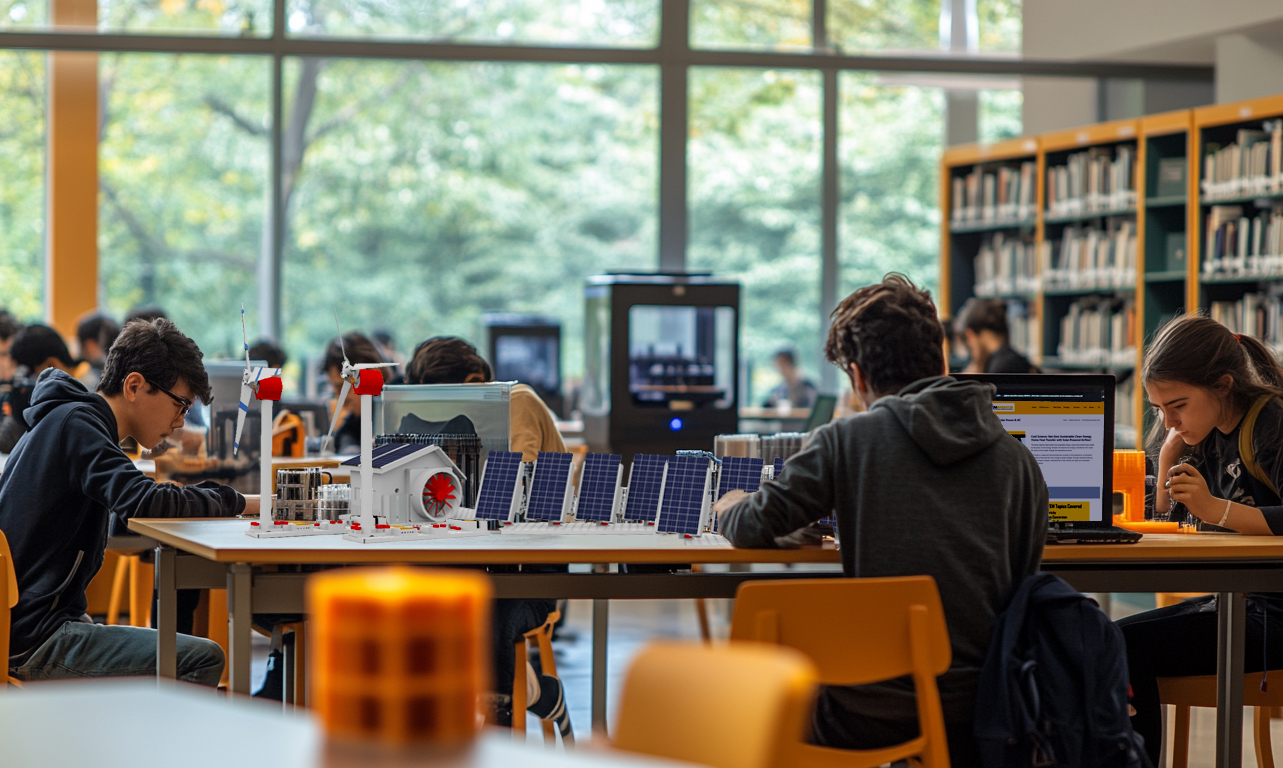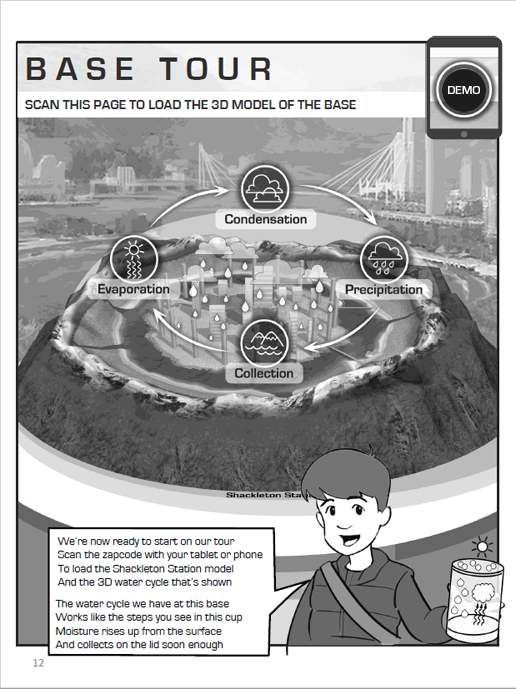The Rockwell Adventures – Water Cycle Engineer
Join the Rockwell family as they travel to several colonies on the Moon to learn more about the water cycle. This fun-filled educational adventure teaches students basic facts about each step of the water cycle, and challenges them to setup the water cycle at a new underground Moon base under construction.
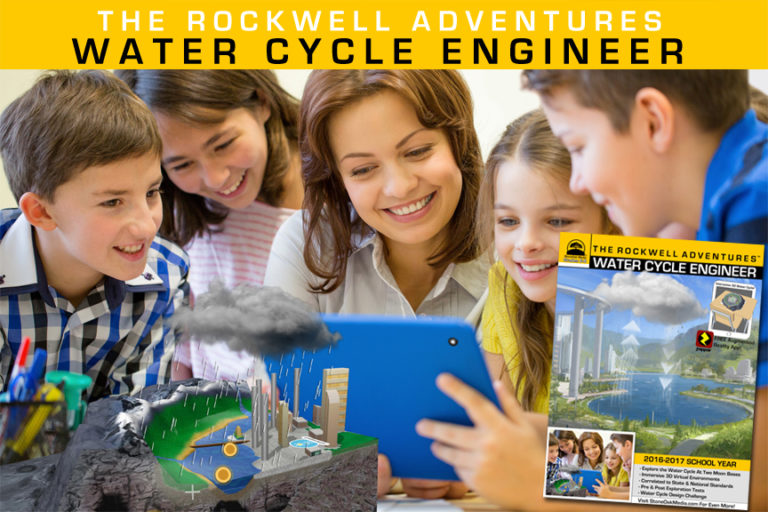
Workbook Overview
What’s Included
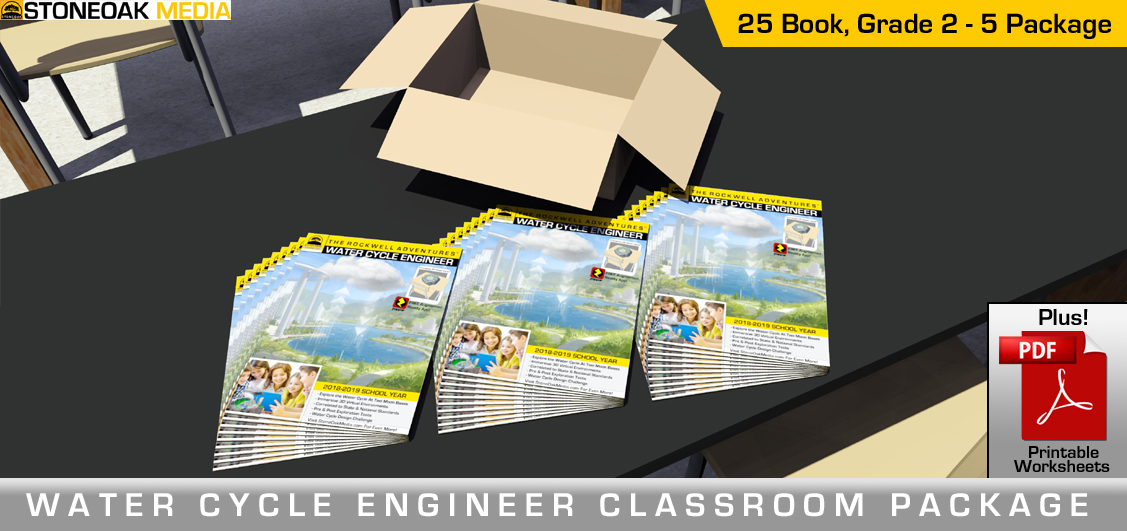
Student Activity Books: Professionally printed and bound copies of this STEM-Focused, Augmented Reality enhanced educational activity book.
Teacher’s Manual: PDF version of the Teacher’s Manual associated with this book. This manual includes easy to print copies of all worksheets that students will consume as part of the lesson.
Lesson Resources
This section contains Teacher’s Manuals for Solar System Expedition, as well as resources that the staff at StoneOak Media, and several collaborating educators have put together to enhance the basic lesson contained in these books. If you’re an educator that has developed extra content supporting these lesson, contact us today. We’re always looking for ways to expand the Solar System Expedition experience!
| Title | Price | Download | |
|---|---|---|---|
 | Large Format Base Design Page: | Free |  |
 | Large Format Base Design Page, With Background | Free |  |
 | Teacher's Manual Elementary School Version | Free |  |
 | Teacher's Manual Middle School Version | Free |  |
Customer Reviews
Note: To write a review, complete the form at the bottom of this page.
Effective and easy to use lesson
I’ve used this lesson for several years in my classroom here in Los Angeles. Since this area of the state is drought prone we put a lot of emphasis on teaching students about the water cycle. We traditionally use a Ziploc bag, partially filled with water, taped to the window to demonstrate this concept. While this works well, students don’t find it very engaging. Since introducing this lesson to my students they have taken a lot more interest in the subject. It’s a solid curriculum standards aligned lesson. It’s very interactive for my students, and very hand’s off for me.
Amazing!
This is a fun way to learn about the water cycle, with amazing immersive experiences! My elementary age home schooler loved the augmented reality [I did too!].
asdad
Single Book
1 Book
- This book provides everything one student needs launch into their tour of the Water Cycle!
- Use with the FREE Zappar Augmented Reality App
Grade 2-5
25 Book Library Package
- This package provides enough copies so that every student in a standard 25 person elementary classroom can have their own copy.
- Use with the FREE Zappar Augmented Reality App
- Pricing is ($19.95/book) x (25 books) x (10% Discount)
Grade 6-8
30 Book Library Package
- This package provides enough copies so that every student in a standard 30 person middle school classroom can have their own copy.
- Use with the FREE Zappar Augmented Reality App
- Pricing is ($19.95/book) x (30 books) x (10% Discount)
About the Workbook
The Rockwell Adventures: Water Cycle Engineer is an educational activity book designed to provide students in grades 2 – 5, and 6 – 8 with a hands-on introduction to Water Cycles. The lesson within this book is centered on the premise that the reader will be serving as the lead engineer on a futuristic mission to setup a water cycle at a new Moon base that is being constructed.
The Mission: After answering some initial questions, the reader’s mission begins with their observing a fully implemented water cycle at a futuristic base on the Moon. After taking a virtual tour of the various stages of the water cycle within this base, they then travel to a new subterranean Moon base under construction. At this new base, they apply what they’ve learned to setup a sustainable water cycle.
Test Drive The Water Cycle Experience!
On the page shown below, students learn about the second stage of the water cycle: Condensation. To try this experience for yourself, simply install the FREE Zappar app (iOS / Android) on a tablet or smartphone, and follow these simple directions:

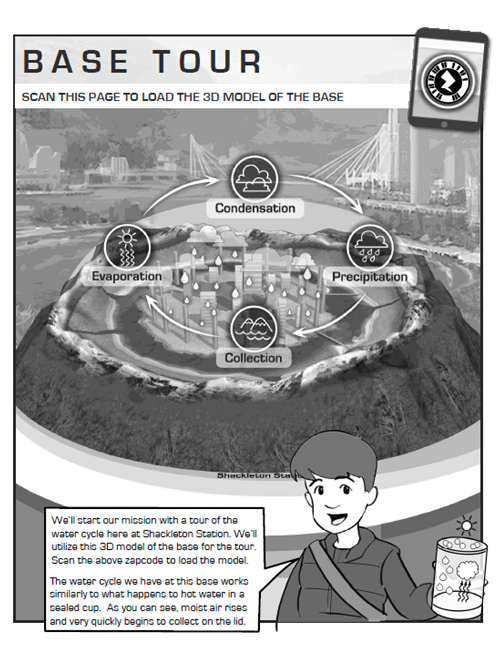
Write a Review
Note: Reviews are typically published within 24 hours of submission.
Curriculum Standards Alignment
National (USA): Common Core NGSS
K – 2nd Grade:
-K-2-ETS1-1 Engineering Design: Ask questions, make observations, and gather information about a situation people want to change to define a simple problem that can be solved through the development of a new or improved object or tool.
-K-2-ETS1-2 Engineering Design: Develop a simple sketch, drawing, or physical model to illustrate how the shape of an object helps it function as needed to solve a given problem.
-1-ESS1 Earth’s Place in the Universe: Use observations of the sun, moon, and stars to describe patterns that can be predicted
Grade 3:
-3-5-ETS1-1 Engineering Design: Define a simple design problem reflecting a need or a want that includes specified criteria for success and constraints on materials, time, or cost.
-3-5-ETS1-2 Engineering Design: Generate and compare multiple possible solutions to a problem based on how well each is likely to meet the criteria and constraints of the problem.
Grade 4:
-3-5-ETS1-1 Engineering Design: Define a simple design problem reflecting a need or a want that includes specified criteria for success and constraints on materials, time, or cost.
-3-5-ETS1-2 Engineering Design: Generate and compare multiple possible solutions to a problem based on how well each is likely to meet the criteria and constraints of the problem.
Grade 5:
-3-5-ETS1-1 Engineering Design: Define a simple design problem reflecting a need or a want that includes specified criteria for success and constraints on materials, time, or cost.
-3-5-ETS1-2 Engineering Design: Generate and compare multiple possible solutions to a problem based on how well each is likely
Middle School (6-8)
-MS-ESS2-4 Earth’s Systems: Develop a model to describe the cycling of water through Earth’s systems driven by energy from the sun and the force of gravity.
-MS-ETS1-1 Engineering Design: Define the criteria and constraints of a design problem with sufficient precision to ensure a successful solution, taking into account relevant scientific principles and potential impacts on people and the natural environment that may limit possible solutions.
-MS-ETS1-2 Engineering Design: Evaluate competing design solutions using a systematic process to determine how well they meet the criteria and constraints of the problem.
-MS-ETS1-3 Engineering Design: Analyze data from tests to determine similarities and differences among several design solutions to identify the best characteristics of each that can be combined into a new solution to better meet the criteria for success
Texas: TEKS
Grade 1:
-112.12 (2) Scientific Investigation & Reasoning: (a) Collecting data and making simple observations, (c) record and organize data, (e) communicate observations
Grade 2:
-112.13 (3) Scientific Investigation & Reasoning: (a) identify and explain a problem and propose a solution.
-112.13 (8) Earth & Space: (c) explore the processes in the water cycle, including evaporation, condensation, and precipitation, as connected to weather conditions;
Grade 3:
-112.13 (8) Earth & Space: (b) describe and illustrate the Sun […] provides light and heat energy for the water cycle
Grade 4:
-112.15 (2): Scientific Investigation & Reasoning: (b) collect and record data by observing and measuring, using the metric system, and using descriptive words and numerals such as labeled drawings, writing. (c) construct simple tables, (d) analyze data and interpret patterns. (f) communicate valid results supported by data.
-112.13 (8) Earth & Space: (b) describe and illustrate the continuous movement of water above and on the surface of Earth through the water cycle and explain the role of the Sun as a major source of energy in this process;
Grade 5:
-112.16 (2): Scientific Investigation & Reasoning: (c) Collect information by detailed observations and accurate measuring. (g) construct appropriate simple graphs, tables to organize, examine, and evaluate information.
-112.16 [6]: Scientific Investigation & Reasoning: (a) Collect, record, analyze data using cameras, computers, metric rulers, thermometers, Sun, Earth, Moon system models, timing devices
-112.13 (8) Earth & Space: (b) explain how the Sun and the ocean interact in the water cycle;
Grade 6:
-112.18 (4) Scientific Investigation & Reasoning: (a) collect, record, and compare information using tools, including computers, notebooks,
Grade 7:
-112.19 (2) Scientific Investigation & Reasoning: (b) collect and record data using the International System of Units (SI) and qualitative means such as labeled drawings, writing, and graphic organizers.
Florida: NGSSS
Grade 2:
Earth and Space Science: Earth Systems and Patterns
– 2.E.7.1: Compare and describe changing patterns in nature that repeat themselves, such as weather conditions including temperature and precipitation, day to day and season to season.
Grade 5:
Earth and Space Science: Earth Systems and Patterns
– 5.E.7.1: Create a model to explain the parts of the water cycle. Water can be a gas, a liquid, or a solid and can go back and forth from one state to another.
– 5.E.7.2:Recognize that the ocean is an integral part of the water cycle and is connected to all of Earth’s water reservoirs via evaporation and precipitation processes.
Grade 6:
Earth and Space Science: Earth Systems and Patterns
– 6.E.7.2: Investigate and apply how the cycling of water between the atmosphere and hydrosphere has an effect on weather patterns and climate.
Grade 7:
Physical Science: Energy Transfer and Transformations
– SC.7.P.11.1: Recognize that adding heat to or removing heat from a system may result in a temperature change and possibly a change of state.
